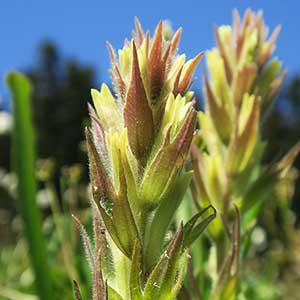Castilleja cryptantha
Castilleja arachnoidea
Mt. Rainier or obscure paintbrush, obscure Indian paintbrush, obscure paintbrush
cobwebby Indian paintbrush, cobwebby paintbrush, cotton paintbrush
few to several, erect or ascending, unbranched, hairs spreading, long, soft, eglandular, mixed with short stipitate-glandular ones.
solitary or few to many, decumbent-ascending, unbranched, sometimes branched, hairs dense, reflexed-spreading, matted, long, soft, unbranched, eglandular, white-woolly.
green, often with brown or purple veins, narrowly to broadly lanceolate, 1.5–4 cm, not fleshy, margins plane, ± involute, 0–3-lobed, apex acute to acuminate;
lobes spreading-ascending, narrowly lanceolate, apex acute to ± obtuse.
green to purple or steel gray, lanceolate-linear or narrowly lanceolate, (1–)2–4(–6) cm, not fleshy, margins plane, involute, 3(–5)-lobed, apex acute;
lobes spreading, linear to lanceolate, apex acute to rounded.
(2.5–)3–6 × 1–2 cm; green to dull brown or dull reddish purple throughout, or proximally green to dull brown or dull reddish purple, distally yellow on apices, broadly lanceolate to ovate, (0–)3-lobed;
lobes ascending, narrowly lanceolate, long or short, arising near mid length, apex acute or acuminate.
erect to ascending, 3–12 × 1–2.5 cm;
bracts proximally greenish to dull reddish brown, rarely dull red or dull orange, distally dull red, deep rusty red, or yellow to pale yellow, sometimes deep pink, dull rose, pale salmon, or dull light orange, rarely green, dull reddish, or dull orange throughout, aging browner and/or more orange, lanceolate or elliptic-lanceolate to obovate, (0–)3–5-lobed;
lobes usually ascending, linear, lanceolate, oblanceolate, or spatulate, long, arising near or below mid length, central lobe apex rounded to truncate, others obtuse to rounded.
straight, 14–16 mm;
tube 11–14 mm;
whole corolla included within calyx;
beak adaxially pale yellow, 1–2 mm;
abaxial lip deep green, slightly inflated, 4–5 mm, 67% as long as beak;
teeth ascending, pale, 1.5–2 mm.
straight or ± curved, 12–20 mm;
tube 9–15 mm;
beak subequal to calyx or slightly exserted, adaxially green or yellow-green, (2–)3–5 mm, ± densely puberulent, hairs often crisped;
abaxial lip yellow, greenish, pink, or red-violet, moderately conspicuous, exserted to barely included in calyx;
pouches shallow, prominent, 2–4 mm, ca. 100% as long as beak;
teeth erect, red, pink, or pale yellow, 1 mm.
proximally green or pale with green veins, lobes yellow, sometimes becoming deep red with age, 12–15 mm;
abaxial and adaxial clefts 3–7 mm, 25–50% of calyx length, deeper than laterals, lateral 1–3(–4) mm, 8–20% of calyx length;
lobes triangular, adaxial segments longer than abaxials, apex acute or obtuse.
colored as bracts, proximal part sometimes paler, (10–)12–19 mm;
abaxial and adaxial clefts 4–8(–10) mm, 33–50% of calyx length, all 4 clefts subequal;
lobes linear to lanceolate, apex acute.
= 24.
= 24.
Castilleja cryptantha
Castilleja arachnoidea
Castilleja cryptantha is endemic to the vicinity of Mt. Rainier in the Cascade Range, with most populations found within Mt. Rainier National Park. Unlike most species of Castilleja, it is apparently self-pollinating (W. J. Duffield 1972); the small flowers are entirely enclosed within the yellowish calyces, which tend to grow deep reddish as they age. The purplish brown bracts are also unusual in the genus.
(Discussion copyrighted by Flora of North America; reprinted with permission.)
Castilleja arachnoidea is a remarkably variable species in form and color, but inflorescence colors are often uniform within a population. It is sometimes confused with C. schizotricha, but the two differ in stature, lobing of the leaves and bracts, bract coloration, and inflation of the abaxial lip. They are easily separated by the simple hairs and pale yellow to brick red inflorescences of C. arachnoidea, compared to the pink-purple to deep purple inflorescences and branched hairs of C. schizotricha.
The names Castilleja eastwoodiana and C. filifolia represent yellow color forms of C. arachnoidea. A race on the pumice plains of Mt. Shasta in the Cascade Range in California is distinctive.
(Discussion copyrighted by Flora of North America; reprinted with permission.)


